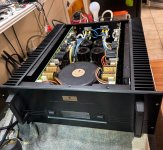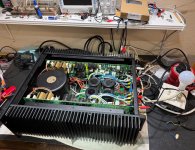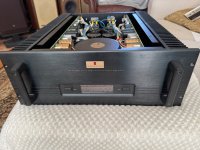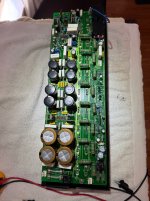New to diyaudio and my first post, thanks in advance for any help and advice. I just picked up a Parasound HCA-3500 amp with L channel out and was hoping for an easy fix. After doing some research and basic troubleshooting, I discovered all of the Sanken 2SC3264/2SA1295 outputs (MT-200) are testing blown in circuit. It looks like there are no longer new replacement outputs available and only a small number of working ones are out there on the used market if you can find them. Did not know this when I took it on as a repair project.
I removed 2 of the 2SA1295’s and one tested bad and the other good, though both tested bad in circuit, so probably need to remove and test all to truly know the extent of the damage to the outputs.
I am not sure if this is a restore I would want to take on considering the discontinued output transistors/lack of good sub and the complexity of the design, and I am just a vintage restoration hobbyists with a couple dozen or so repairs/restorations under my belt and not a trained technician. I am thinking of passing this amp on to more qualified hands but just wanted to check with the group first if anyone has experience with this type of amp with output transistor issues and advice on my predicament?
I removed 2 of the 2SA1295’s and one tested bad and the other good, though both tested bad in circuit, so probably need to remove and test all to truly know the extent of the damage to the outputs.
I am not sure if this is a restore I would want to take on considering the discontinued output transistors/lack of good sub and the complexity of the design, and I am just a vintage restoration hobbyists with a couple dozen or so repairs/restorations under my belt and not a trained technician. I am thinking of passing this amp on to more qualified hands but just wanted to check with the group first if anyone has experience with this type of amp with output transistor issues and advice on my predicament?
Attachments
All those outputs are matched btw, in case you were wondering.
Someone can probably find substitute parts and modify the remaining circuitry to compensate, do both channels.
Someone can probably find substitute parts and modify the remaining circuitry to compensate, do both channels.
Might take a look at this thread. https://www.diyaudio.com/community/threads/sanken-2sa1295-and-2sc3264.418866/#post-7868448
Digikey is showing large stock of both of those transistors under the Revvo brand, for $3.64 each. Buy 20 of each and start matching!
By matched do you mean hFE matched from factory or complementary NPN PNP pairs? There are some MJW3281 outputs that can be subbed with specialAll those outputs are matched btw, in case you were wondering.
Someone can probably find substitute parts and modify the remaining circuitry to compensate, do both channels.
tie down adapters but I heard they can come with oscillation issues and not as good a sound as the original Sankens. And then to do both channels to match, that would be 32 outputs and quite a chunk of change. That is why I thought some old stock replacements would be more economical if some or most of the other outputs are ok. So are you saying the MT-200’s have to be matched pairs and only purchased in complementary pairs?
Of course this is just the first issue, if I decide to take this project on then I have to figure out what on the driver board blew them out to begin with.
All sixteen output devices are blown ? - unbelievableI discovered all of the Sanken 2SC3264/2SA1295 outputs (MT-200) are testing blown in circuit.
If one output is blown on a channel, al the outputs go and are replaced with a matched set. Also the drivers, always go one stage back from the last blown one.
I can't see any reason why you would do the other channel, those are unrelated electrically.
I can't see any reason why you would do the other channel, those are unrelated electrically.
I know, I need to unsolder them to confirm, when removing the first couple of 2SA1295’s in line after the Q38 transistor (2SK1530), the first one was shorted on all legs and the second one tested fine. I will need to unsolder and number them to keep them matched to assess how many have been shorted. I am hoping maybe the first one in line shorted and the relay did its job to protect the rest of them?All sixteen output devices are blown ? - unbelievable
The relay protects the speaker (load) only.
When the output section is stressed past it's collective SOA, one or more may fail short. The other polarity is now subjected to a direct short to the opposite supply and the voltage amp section does it's best to maintain zero DC offset by doing what? Turning the other polarity on as hard as it can, so you have transistors fighting a wire to the opposite supply.
Do you think this is good for those transistors in any way? Generally the transistors that didn't outright fail then have their characteristics changed, and some may fail short later. The driver transistors were also operated well beyond their limits. They suffer the same changes and may fail at a later date also.
I know it isn't what you want to hear. I don't sell transistors, I don't care how many you have to buy. I do care that you repair your amplifier in a way that it performs properly and is reliable. So take a moment and think about this. I've been repairing audio for almost 50 years, very well made equipment. I'm not about to mislead you.
- Chris
When the output section is stressed past it's collective SOA, one or more may fail short. The other polarity is now subjected to a direct short to the opposite supply and the voltage amp section does it's best to maintain zero DC offset by doing what? Turning the other polarity on as hard as it can, so you have transistors fighting a wire to the opposite supply.
Do you think this is good for those transistors in any way? Generally the transistors that didn't outright fail then have their characteristics changed, and some may fail short later. The driver transistors were also operated well beyond their limits. They suffer the same changes and may fail at a later date also.
I know it isn't what you want to hear. I don't sell transistors, I don't care how many you have to buy. I do care that you repair your amplifier in a way that it performs properly and is reliable. So take a moment and think about this. I've been repairing audio for almost 50 years, very well made equipment. I'm not about to mislead you.
- Chris
I understand what you are saying Chris and agree with it, just not sure I can afford this restore for 16 more outputs (plus all the other driver board components needing replacement) and not sure of the reliability of the new Revvo brand manufacturing the output subs. I picked up this project on a whim, it is way too much amp for my speakers and was just wanting to repair it, if it was easy, and pass it on to someone else. I assumed that if it turned out to be too much I would just resell it for parts or restore to someone else. If I can’t find someone else to buy it I guess I will have to start saving up for those outputs.
I was picturing an entire swap out of the outputs for a different variety (brand/package) of parts, then doing the other channel to match.
Really didn’t think the original types were a viable option, but if so, then yes, only one channel would need replacements…
Really didn’t think the original types were a viable option, but if so, then yes, only one channel would need replacements…
MJL3281/1302 are among the more well-matched devices out of the tube that you can get. You will have to buy less of those than other solutions to get 32 matched.
Hi Jackson,
I think the worst thing one person can do to another is repair something improperly and sell it to someone else. You stand to cause further damage to the equipment, speakers and the equipment also fails to perform as it should. In other words, it isn't a Parasound anymore. I see this very commonly on my bench. Poor service greatly increases repair costs and that isn't fair to the next person and technician who has to clean up afterwards.
I think the output relay contacts are probably damaged.
wg_ski is correct about the output type. Those are my preferred devices also. In-batch matching is better, but I still hand match them. This is a really good amplifier. I like the option of saving up and doing it properly so you can use it. This is your chance to own a good amplifier. Nothing wrong with too much power (within reason). If not, sell it as is to someone who will fix it properly.
Too much amplifier? lol! I'm using a Marantz 170DC to drive my bathroom in-wall speakers. Sounds better (that's the reason), but I could lay waste to those speakers. You are actually at higher risk of blowing speakers with smaller amplifiers. Just be reasonable, as in I'm not using a 250 wpc amp to drive in-walls, just 85 wpc.
I think the worst thing one person can do to another is repair something improperly and sell it to someone else. You stand to cause further damage to the equipment, speakers and the equipment also fails to perform as it should. In other words, it isn't a Parasound anymore. I see this very commonly on my bench. Poor service greatly increases repair costs and that isn't fair to the next person and technician who has to clean up afterwards.
I think the output relay contacts are probably damaged.
wg_ski is correct about the output type. Those are my preferred devices also. In-batch matching is better, but I still hand match them. This is a really good amplifier. I like the option of saving up and doing it properly so you can use it. This is your chance to own a good amplifier. Nothing wrong with too much power (within reason). If not, sell it as is to someone who will fix it properly.
Too much amplifier? lol! I'm using a Marantz 170DC to drive my bathroom in-wall speakers. Sounds better (that's the reason), but I could lay waste to those speakers. You are actually at higher risk of blowing speakers with smaller amplifiers. Just be reasonable, as in I'm not using a 250 wpc amp to drive in-walls, just 85 wpc.
I certainly have no intention of repairing it improperly and passing it on to some other unsuspecting buyer, I have done a lot of very complex full restorations (Sansui 9090, 9090DB, 8080, Mac1900, Dynaco ST-400) and pride myself on the meticulous attention to detail and careful research on what needs to be done to fully bring a stereo back to as new as possible and still maintain as much original sound as possible. My post has been all about ascertaining what this amp will need to be fully restored to my standards so I can decide if I want to take it on or not. And the type of outputs needed and choice between used ones or brand new ones has been the thing I have been struggling with and appreciate all of the input I have gotten.
If all 36 of the 3281/1306 outputs were used, would the sound be similar or the same over the discontinued MT-200 Sankens? I see some posts saying the original Sankens sound best and the new outputs alter the sound, any truth to that?
And the other HCA-3500 post referenced above mentioned that all of the block and axial white film caps are prone to shorting, would all of those need replacing too thru a full restore?Just trying to put together an idea of the full restore cost on both channels to make it a reliable amp for decades to come. If there are other places to check for restoration advice on the HCA-3500, please share. I am having a hard time finding a lot of repair threads online.
If all 36 of the 3281/1306 outputs were used, would the sound be similar or the same over the discontinued MT-200 Sankens? I see some posts saying the original Sankens sound best and the new outputs alter the sound, any truth to that?
And the other HCA-3500 post referenced above mentioned that all of the block and axial white film caps are prone to shorting, would all of those need replacing too thru a full restore?Just trying to put together an idea of the full restore cost on both channels to make it a reliable amp for decades to come. If there are other places to check for restoration advice on the HCA-3500, please share. I am having a hard time finding a lot of repair threads online.
Hi Jackson,
No problem and good to hear.
Just do one channel for starters. Go to Parasound's website, they have been putting up information packs for their products, it is a work in progress. You may find some detailed information there you can use.
It's good to figure out what you're in for first. I doubt strongly the sound will change, but you may have to compensate the amplifier for HF stability again. Any time you change output or driver transistor numbers on any amplifier, you need to check HF stability. I can't speak to those capacitors shorting. I generally measure capacitors using an HP LCR meter. If DA is high, or capacitance is low, out they go.
I have talked to Parasound, and they have launched their "Repair Ready" program. They have authorized some shops to do out of warranty service in response to the awful state of service out there. They will only release service information to those shops for newer products. I'm one of them. They are very strict, I cannot release service information.
No problem and good to hear.
Just do one channel for starters. Go to Parasound's website, they have been putting up information packs for their products, it is a work in progress. You may find some detailed information there you can use.
It's good to figure out what you're in for first. I doubt strongly the sound will change, but you may have to compensate the amplifier for HF stability again. Any time you change output or driver transistor numbers on any amplifier, you need to check HF stability. I can't speak to those capacitors shorting. I generally measure capacitors using an HP LCR meter. If DA is high, or capacitance is low, out they go.
I have talked to Parasound, and they have launched their "Repair Ready" program. They have authorized some shops to do out of warranty service in response to the awful state of service out there. They will only release service information to those shops for newer products. I'm one of them. They are very strict, I cannot release service information.
Thanks Chris, this is great info! I was thinking the electrolytics under 1000uf could go, not sure if the 1000 up would need checking or replacing? The white films could be replaced with Panasonic ECW series, assume those little yellow axial caps should be ok? Other than that, there’s just an assortment of transistors to research/test and some diodes.
BTW, D35 zener 30v reads in both directions and R46 smoked a little when I was running it on dim bulb for just a min before finding shorted outputs, but the L channel never came out of protection or lit the bulb, so assume outputs were shorted already when I got it. But based on your last posts, all of those transistors tracing back from the shorted output may have been compromised and should be replaced. I am feeling more comfortable with this restoration, I would rather error on the side of caution and replace suspect caps, transistors and diodes since they are usually relatively cheap.
BTW, D35 zener 30v reads in both directions and R46 smoked a little when I was running it on dim bulb for just a min before finding shorted outputs, but the L channel never came out of protection or lit the bulb, so assume outputs were shorted already when I got it. But based on your last posts, all of those transistors tracing back from the shorted output may have been compromised and should be replaced. I am feeling more comfortable with this restoration, I would rather error on the side of caution and replace suspect caps, transistors and diodes since they are usually relatively cheap.
Perhaps more importantly... doing a Deep Dive here.... what would be the root cause for all this damage?
The amp seems well designed and well built and it's not that old... so why would it suffer such damage?
The amp seems well designed and well built and it's not that old... so why would it suffer such damage?
Hi Jackson,
Don't get married to any particular capacitor brand/model. Just get good ones. Don't replace capacitors without reason. You must properly form capacitor leads if the lead spacing isn't the same. Do not replace all capacitors just because or for "upgrade" purposes.
Yes, always replace one stage past the last dead part. If you have a BJT differential pair, you need to replace those with a closely matched pair. During a failure you often get a large DC offset, that reverse biases one input transistor junction and damages it very often. I designed a jig for that decades ago and later gave it to this community. Several PCBs have been designed for it. It is a beta matcher and matches transistors exactly, easy to use and not an expensive thing to build.
Hi Tony,
We get tons of amplifier sections in under warranty every year (not Parasound, but all brands). People blow stuff up, plus you can have isolated component failure (early death) for no reason. Shorted speaker leads, failure to provide ventilation, stupid speaker designs. The list goes on. Revox bench checked each and every piece before shipping to the local dealer in Canada. Stuff still failed. The consumer is often not forthcoming about the actual cause for the failure, many haven't a clue. They don't want to pay for service, so don't expect honest answers (some are). I even had one guy who designed a subwoofer crossover and blew up a large Adcom a few times. First element in his design? A large capacitor across the amplifier output in the subwoofer box. Then he argued, then claimed it was warranty anyway. Sometimes manufacturers can't win. I barred him from warranty and he paid for repair for blow-up #3. I've had products fail because the owners manual was placed on top of the unit.
Use your imagination. There are all kinds of ways for a unit to fail not due to design or materials.
Don't get married to any particular capacitor brand/model. Just get good ones. Don't replace capacitors without reason. You must properly form capacitor leads if the lead spacing isn't the same. Do not replace all capacitors just because or for "upgrade" purposes.
Yes, always replace one stage past the last dead part. If you have a BJT differential pair, you need to replace those with a closely matched pair. During a failure you often get a large DC offset, that reverse biases one input transistor junction and damages it very often. I designed a jig for that decades ago and later gave it to this community. Several PCBs have been designed for it. It is a beta matcher and matches transistors exactly, easy to use and not an expensive thing to build.
Hi Tony,
We get tons of amplifier sections in under warranty every year (not Parasound, but all brands). People blow stuff up, plus you can have isolated component failure (early death) for no reason. Shorted speaker leads, failure to provide ventilation, stupid speaker designs. The list goes on. Revox bench checked each and every piece before shipping to the local dealer in Canada. Stuff still failed. The consumer is often not forthcoming about the actual cause for the failure, many haven't a clue. They don't want to pay for service, so don't expect honest answers (some are). I even had one guy who designed a subwoofer crossover and blew up a large Adcom a few times. First element in his design? A large capacitor across the amplifier output in the subwoofer box. Then he argued, then claimed it was warranty anyway. Sometimes manufacturers can't win. I barred him from warranty and he paid for repair for blow-up #3. I've had products fail because the owners manual was placed on top of the unit.
Use your imagination. There are all kinds of ways for a unit to fail not due to design or materials.
Digikey is showing large stock of both of those transistors under the Revvo brand, for $3.64 each. Buy 20 of each and start matching!
Their data sheets contain a boat load of errors. They’ve confused the old Sanken parts with the On MJL stuff - swapping the data and mixing “complementary” types. Trust is earned, and so far I’ve got reason to be skeptical.
- Home
- Amplifiers
- Solid State
- Parasound HCA-3500 with blown outputs



